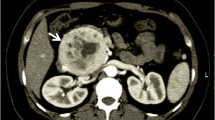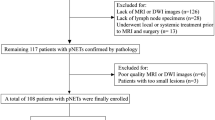Abstract
Purpose
To identify whether the features of preoperative MDCT or EUS could predict the histopathological grading scheme of pancreatic neuroendocrine neoplasms (pNENs).
Methods
A total of 25 patients with pNENs were enrolled in the present study. The qualitative and quantitative variables were reviewed. The qualitative variables included location, contour, border, necrosis, intratumoral vessel, homogeneity, calcification, peripancreatic fat/vessel infiltration, pancreatic duct dilatation, mass within pancreas, lymphadenopathy and hepatic metastasis on MDCT and border, echogenicity, cystic/solid and blood flow on EUS. The quantitative variables included long diameter (LD), short diameter (SD), unenhanced mass attenuation (UMA), unenhanced pancreatic attenuation (UPA), arterial phase mass attenuation (APMA), arterial phase pancreatic attenuation (APPA), portal venous phase mass attenuation (PVPMA), portal venous phase pancreatic attenuation (PVPPA), arterial phase enhancement degree (APED) and portal venous phase enhancement degree (PVPED). In addition, sex and age were also evaluated. Histopathological classifications met the criterion of 2010 edition WHO Histopathological Classifications. Kruskal–Wallis test and Boruta algorithm were conducted.
Results
Lymphadenopathy and peripancreatic fat or vascular invasion foretold higher histopathological grading level while well-defined border on EUS image lower grading level.
Conclusions
Lymphadenopathy, border on EUS image and peripancreatic fat or vascular invasion can predict the histopathological grading scheme of pNENs.



Similar content being viewed by others

References
Oberg K, Eriksson B (2005) Endocrine tumours of the pancreas. Best Pract Res Clin Gastroenterol 19:753–781
Halfdanarson TR, Rabe KG, Rubin J et al (2008) Pancreatic neuroendocrine tumors (PNETs): incidence, prognosis and recent trend toward improved survival. Ann Oncol 19:1727–1733
Chen H, Hardacre JM, Uzar A et al (1998) Isolated liver metastases from neuroendocrine tumors: does resection prolong survival. J Am Coll Surg 187:88–92
Karaman K, Bostanci EB, Aksoy E et al (2011) The predictive value of mean platelet volume in differential diagnosis of non-functional pancreatic neuroendocrine tumors from pancreatic adenocarcinomas. Eur J Intern Med 22:e95–e98
Sundin A, Vullierme MP, Kaltsas G et al (2009) ENETS Consensus Guidelines for the Standards of Care in Neuroendocrine Tumors: radiological examinations. Neuroendocrinology 90:167–183
Maletta F, Pacchioni D, Carucci P et al (2011) Analysis of cyst fluid obtained by endoscopic ultrasound-guided fine-needle aspiration supporting the diagnosis of a pancreatic neuroendocrine neoplasm. Endoscopy 43(Suppl 2 UCTN):E34–E35
Larghi A, Capurso G, Carnuccio A et al (2012) Ki-67 grading of nonfunctioning pancreatic neuroendocrine tumors on histologic samples obtained by EUS-guided fine-needle tissue acquisition: a prospective study. Gastrointest Endosc 76:570–577
Pais SA, Al-Haddad M, Mohamadnejad M et al (2010) EUS for pancreatic neuroendocrine tumors: a single-center, 11-year experience. Gastrointest Endosc 71:1185–1193
Jensen RT, Cadiot G, Brandi ML et al (2012) ENETS Consensus Guidelines for the management of patients with digestive neuroendocrine neoplasms: functional pancreatic endocrine tumor syndromes. Neuroendocrinology 95:98–119
Falconi M, Bartsch DK, Eriksson B et al (2012) ENETS Consensus Guidelines for the management of patients with digestive neuroendocrine neoplasms of the digestive system: well-differentiated pancreatic non-functioning tumors. Neuroendocrinology 95:120–134
Kulke MH, Benson AB 3rd, Bergsland E et al (2012) Neuroendocrine tumors. J Natl Compr Canc Netw 10:724–764
Bosman F Carneiro F, Hruban R Theise N (2010) WHO Classification of Tumours of the Digestive System
Liaw AWM (2000) Classification and regression by randomForest. R News 2:18–22
Kursa MB, Rudnicki WR (2010) Feature selection with the boruta package. J Stat Softw 36:1–13
Schott M, Klöppel G, Raffel A et al (2011) Neuroendocrine neoplasms of the gastrointestinal tract. Dtsch Arztebl Int 108:305–312
van Essen M, Sundin A, Krenning EP et al (2014) Neuroendocrine tumours: the role of imaging for diagnosis and therapy. Nat Rev Endocrinol 10:102–114
Sharma P, Arora S, Mukherjee A et al (2014) Predictive value of 68Ga-DOTANOC PET/CT in patients with suspicion of neuroendocrine tumors: is its routine use justified. Clin Nucl Med 39:37–43
Etchebehere EC, de Santos Oliveira A, Gumz B et al (2014) 68Ga-DOTATATE PET/CT, 99mTc-HYNIC-octreotide SPECT/CT, and whole-body MR imaging in detection of neuroendocrine tumors: a prospective trial. J Nucl Med 55:1598–1604
Sahani DV, Bonaffini PA, Fernandez-Del CC et al (2013) Gastroenteropancreatic neuroendocrine tumors: role of imaging in diagnosis and management. Radiology 266:38–61
James PD, Tsolakis AV, Zhang M et al (2015) Incremental benefit of preoperative EUS for the detection of pancreatic neuroendocrine tumors: a meta-analysis. Gastrointest Endosc 81(848–856):e1
Jang KM, Kim SH, Lee SJ et al (2014) The value of gadoxetic acid-enhanced and diffusion-weighted MRI for prediction of grading of pancreatic neuroendocrine tumors. Acta Radiol 55:140–148
Hwang EJ, Lee JM, Yoon JH et al (2014) Intravoxel incoherent motion diffusion-weighted imaging of pancreatic neuroendocrine tumors: prediction of the histologic grade using pure diffusion coefficient and tumor size. Invest Radiol 49:396–402
Tomimaru Y, Eguchi H, Tatsumi M et al (2015) Clinical utility of 2-[(18)F] fluoro-2-deoxy-d-glucose positron emission tomography in predicting World Health Organization grade in pancreatic neuroendocrine tumors. Surgery 157:269–276
Turaga KK, Kvols LK (2011) Recent progress in the understanding, diagnosis, and treatment of gastroenteropancreatic neuroendocrine tumors. CA Cancer J Clin 61:113–132
Khashab MA, Yong E, Lennon AM et al (2011) EUS is still superior to multidetector computerized tomography for detection of pancreatic neuroendocrine tumors. Gastrointest Endosc 73:691–696
Ridtitid W, Halawi H, DeWitt JM et al (2015) Cystic pancreatic neuroendocrine tumors: outcomes of preoperative endosonography-guided fine needle aspiration, and recurrence during long-term follow-up. Endoscopy 47:617–625
Yoon WJ, Daglilar ES, Pitman MB et al (2013) Cystic pancreatic neuroendocrine tumors: endoscopic ultrasound and fine-needle aspiration characteristics. Endoscopy 45:189–194
Gallotti A, Johnston RP, Bonaffini PA et al (2013) Incidental neuroendocrine tumors of the pancreas: MDCT findings and features of malignancy. AJR Am J Roentgenol 200:355–362
Luo Y, Dong Z, Chen J et al (2014) Pancreatic neuroendocrine tumours: correlation between MSCT features and pathological classification. Eur Radiol 24:2945–2952
Kishi Y, Shimada K, Nara S et al (2014) Basing treatment strategy for non-functional pancreatic neuroendocrine tumors on tumor size. Ann Surg Oncol 21:2882–2888
Worhunsky DJ, Krampitz GW, Poullos PD et al (2014) Pancreatic neuroendocrine tumours: hypoenhancement on arterial phase computed tomography predicts biological aggressiveness. HPB (Oxford) 16:304–311
Author information
Authors and Affiliations
Corresponding author
Ethics declarations
Conflict of interest
We declare that there are no conflicts of interest in this study. We have not received any funding in this study.
Ethical standards
All procedures performed in studies involving human participants were in accordance with the ethical standards of the institutional and/or national research committee and with the 1964 Helsinki declaration and its later amendments or comparable ethical standards. This article does not contain any studies with animals performed by any of the authors.
Additional information
H. Zhu and L. Ying contributed equally to this work.
Rights and permissions
About this article
Cite this article
Zhu, H., Ying, L., Tang, W. et al. Can MDCT or EUS features predict the histopathological grading scheme of pancreatic neuroendocrine neoplasms?. Radiol med 122, 319–326 (2017). https://doi.org/10.1007/s11547-017-0727-9
Received:
Accepted:
Published:
Issue Date:
DOI: https://doi.org/10.1007/s11547-017-0727-9



